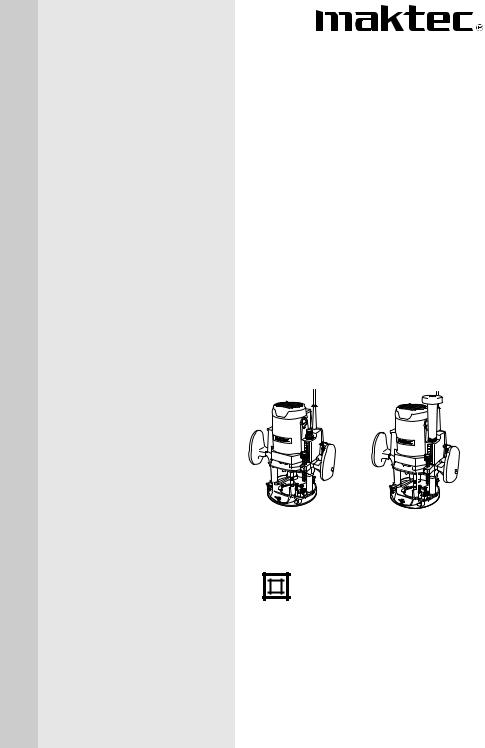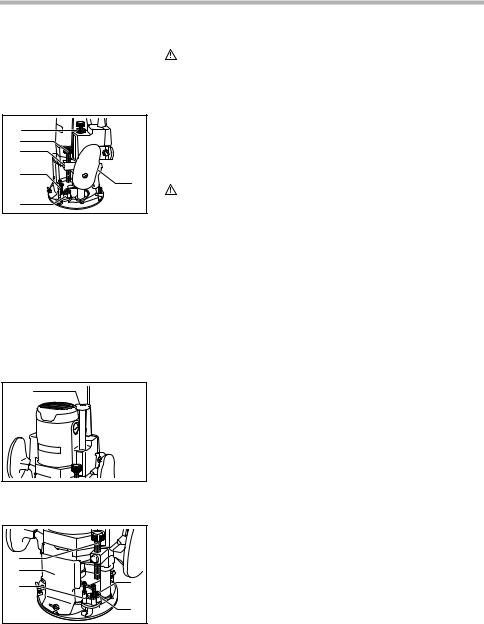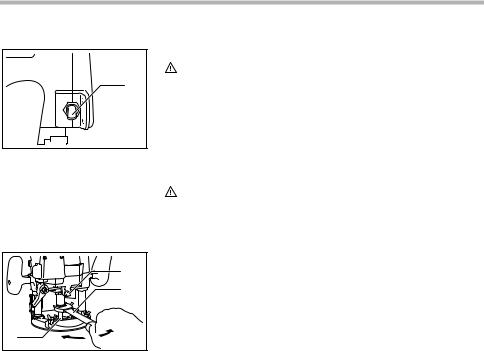Makita MT360 Manual

Router
MODEL MT360
004924 |
005110 |
DOUBLE
INSULATION
I N S T R U C T I O N M A N U A L
 WARNING:
WARNING:
For your personal safety, READ and UNDERSTAND before using. SAVE THESE INSTRUCTIONS FOR FUTURE REFERENCE.

SPECIFICATIONS
Model |
MT360 |
|
|
Collet chuck capacity |
12 mm or 1/2” |
|
|
Plunge capacity |
0 - 60 mm |
|
|
No load speed (min-1) |
22,000 |
Overall height |
300 mm |
|
|
Net weight |
5.5 Kg |
|
|
Safety class |
/II |
|
|
•Due to our continuing programme of research and development, the specifications herein are subject to change without notice.
•Note: Specifications may differ from country to country.
GENERAL SAFETY RULES |
ENA100-1 |
 WARNING:
WARNING:
Read all instructions. Failure to follow all instructions listed below may result in electric shock, fire and/or serious injury. The term “power tool” in all of the warnings listed below refers to your mains operated (corded) power tool or battery operated (cordless) power tool.
SAVE THESE INSTRUCTIONS
Work area
1.Keep work area clean and well lit. Cluttered and dark areas invite accidents.
2.Do not operate power tools in explosive atmospheres, such as in the presence of flammable liquids, gases or dust. Power tools create sparks which may ignite the dust or fumes.
3.Keep children and bystanders away while oper-
ating a power tool. Distractions can cause you to lose control.
Electrical safety
4.Power tool plugs must match the outlet. Never modify the plug in any way. Do not use any adapter plugs with earthed (grounded) power tools. Unmodified plugs and matching outlets will reduce risk of electric shock.
5.Avoid body contact with earthed or grounded surfaces such as pipes, radiators, ranges and refrigerators. There is an increased risk of electric shock if your body is earthed or grounded.
6.Do not expose power tools to rain or wet conditions. Water entering a power tool will increase the risk of electric shock.
7.Do not abuse the cord. Never use the cord for carrying, pulling or unplugging the power tool. Keep cord away from heat, oil, sharp edges or moving parts. Damaged or entangled cords increase the risk of electric shock.
8.When operating a power tool outdoors, use an extension cord suitable for outdoor use. Use of a cord suitable for outdoor use reduces the risk of
electric shock.
Personal safety
9.Stay alert, watch what you are doing and use common sense when operating a power tool. Do not use a power tool while you are tired or under the influence of drugs, alcohol or medication. A moment of inattention while operating power tools may result in serious personal injury.
10.Use safety equipment. Always wear eye protection. Safety equipment such as dust mask, non-skid safety shoes, hard hat, or hearing protection used for appropriate conditions will reduce personal injuries.
11.Avoid accidental starting. Ensure the switch is in the off position before plugging in. Carrying
2

power tools with your finger on the switch or plugging in power tools that have the switch on invites accidents.
12.Remove any adjusting key or wrench before turning the power tool on. A wrench or a key left attached to a rotating part of the power tool may result in personal injury.
13.Do not overreach. Keep proper footing and balance at all times. This enables better control of the power tool in unexpected situations.
14.Dress properly. Do not wear loose clothing or jewellery. Keep your hair, clothing, and gloves away from moving parts. Loose clothes, jewellery or long hair can be caught in moving parts.
15.If devices are provided for the connection of dust extraction and collection facilities, ensure these are connected and properly used. Use of
these devices can reduce dust related hazards.
Power tool use and care
16.Do not force the power tool. Use the correct power tool for your application. The correct power tool will do the job better and safer at the rate for which it was designed.
17.Do not use the power tool if the switch does not turn it on and off. Any power tool that cannot be controlled with the switch is dangerous and must be repaired.
18.Disconnect the plug from the power source and/ or the battery pack from the power tool before making any adjustments, changing accessories,
or storing power tools. Such preventive safety measures reduce the risk of starting the power tool accidentally.
19.Store idle power tools out of the reach of children and do not allow persons unfamiliar with the power tool or these instructions to operate the power tool. Power tools are dangerous in the hands of untrained users.
20.Maintain power tools. Check for misalignment or binding of moving parts, breakage of parts and any other condition that may affect the power tools operation. If damaged, have the power tool repaired before use. Many accidents are caused by poorly maintained power tools.
21.Keep cutting tools sharp and clean. Properly maintained cutting tools with sharp cutting edges are less likely to bind and are easier to control.
22.Use the power tool, accessories and tool bits etc. in accordance with these instructions and in the manner intended for the particular type of power tool, taking into account the working conditions and the work to be performed. Use of the
power tool for operations different from those intended could result in a hazardous situation.
Service
23.Have your power tool serviced by a qualified repair person using only identical replacement parts. This will ensure that the safety of the power tool is maintained.
ADDITIONAL SAFETY RULES |
ENB033-2 |
1.Hold tool by insulated gripping surfaces when 10. Be careful of the bit rotating direction and the
performing an operation where the cutting tool may contact hidden wiring or its own cord. Contact with a “live” wire will make exposed metal parts of the tool “live” and shock the operator.
2.Wear hearing protection during extended period of operation.
3.Handle the bits very carefully.
4.Check the bit carefully for cracks or damage before operation. Replace cracked or damaged bit immediately.
5.Avoid cutting nails. Inspect for and remove all nails from the workpiece before operation.
6.Hold the tool firmly with both hands.
7.Keep hands away from rotating parts.
8.Make sure the bit is not contacting the workpiece before the switch is turned on.
9.Before using the tool on an actual workpiece, let it run for a while. Watch for vibration or wobbling that could indicate improperly installed bit.
feed direction.
11.Do not leave the tool running. Operate the tool only when hand-held.
12.Always switch off and wait for the bit to come to a complete stop before removing the tool from workpiece.
13.Do not touch the bit immediately after operation; it may be extremely hot and could burn your skin.
14.Always lead the power supply cord away from the tool towards the rear.
15.Do not smear the tool base carelessly with thinner, gasoline, oil or the like. They may cause cracks in the tool base.
16.Draw attention to the need to use cutters of the correct shank diameter and which are suitable for the speed of the tool.
3

SAVE THESE INSTRUCTIONS
4

FUNCTIONAL DESCRIPTION
CAUTION:
•Always be sure that the tool is switched off and unplugged before adjusting or checking function on the tool.
004925 |
1 |
2 |
3 |
4 |
6 |
5 |
1.Nylon nut
2.Stopper pole
3.Fast-feed button
4.Adjusting hex bolt
5.Stopper
6.Lock lever
005111
1
1. Knob
Adjusting the depth of cut
Place the tool on a flat surface. Loosen the lock lever and lower the tool body until the bit just touches the flat surface. Press the lock lever down to lock the tool body. While pressing the fast-feed button, move the stopper pole up or down until the desired depth of cut is obtained. Minute depth adjustments can be obtained by turning the stopper pole (1.5 mm per turn).
CAUTION:
•The depth of cut should not be more than 20 mm at a pass when cutting grooves. For extra-deep grooving operations, make two or three passes with progres-sively deeper bit settings.
Nylon nut
For tool without the knob
The upper limit of the tool body can be adjusted by turning the nylon nut. Do not lower the nylon nut too low. The bit will protrude dangerously.
For tool with the knob
By turning the knob, the upper limit of the tool body can be adjusted. When the tip of the bit is retracted more than required in relation to the base plate surface, turn the knob to lower the upper limit. Do not lower the knob toolow. The bit will protrude dangerously.
|
004926 |
1 |
|
2 |
|
3 |
4 |
|
|
|
5 |
1.Stopper pole
2.Chip deflector
3.Stopper
4.Adjusting hex bolt
5.Hex nut
Stopper block
As the rotary stopper has three adjusting hex bolts, you can easily obtain three different depths of cut without readjusting the stopper pole. To adjust the hex bolts, loosen the hex nuts on them and turn the hex bolts. After obtaining the desired position, tighten the hex nuts to secure the hex bolts.
5

004927 |
1 |
1. Switch lever
Switch action
CAUTION:
•Before plugging in the tool, always check to see that the tool is switched off.
•Make sure that the shaft lock is released before the switch is turned on.
To start the tool, move the switch lever to the I position. To stop the tool, move the switch lever to the O position.
ASSEMBLY
CAUTION:
•Always be sure that the tool is switched off and unplugged before carrying out any work on the tool.
3
1.Shaft lock
2.Wrench
3.Bit
004928 Installing or removing the bit
1 CAUTION:
CAUTION:
2• Install the bit securely. Always use only the wrench provided with the
tool. A loose or overtightened bit can be dangerous.
•Do not tighten the collet nut without inserting a bit or install small shank bits without using a collet sleeve. Either can lead to breakage of the collet cone.
Insert the bit all the way into the collet cone. Press the shaft lock to keep the shaft stationary and use the wrench to tighten the collet nut securely. When using router bits with smaller shank diameter, first insert the appropriate collet sleeve into the collet cone, then install the bit as described above.
To remove the bit, follow the installation procedure in reverse.
6
